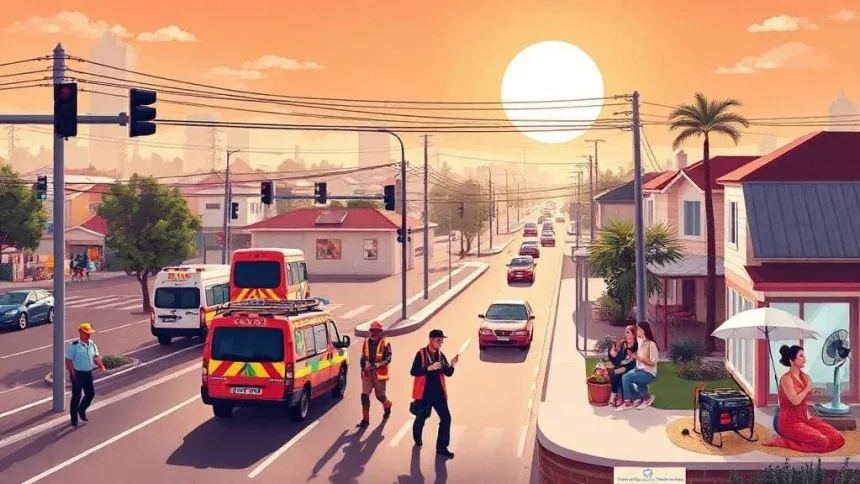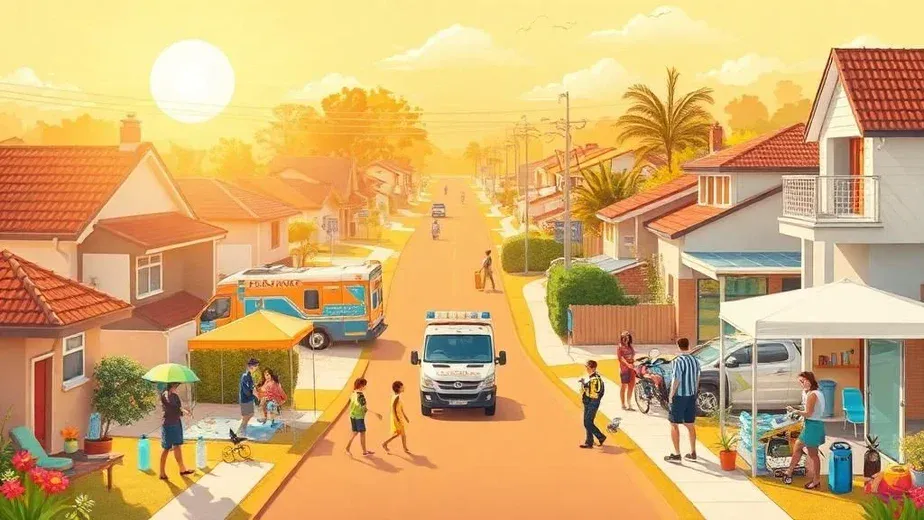Heatwave Blackout: A Multi-Agency Emergency Plan for Households, Businesses, and Responders
A practical, step-by-step guide for managing a heatwave blackout across Australia. Learn how police, fire, ambulance, and SES coordinate during extreme heat, how to keep people safe without power, and how to recover quickly.
Last updated: 17 August 2025
Heat alert
Limit exertion 11:00–18:00, drink water regularly, check neighbours and the elderly, never leave children or pets in vehicles.
Smoke alert
Use P2/N95 masks if advised, close windows, use air purifiers or DIY filters, avoid outdoor exercise when AQI is poor.
Flooding risk
Storms after heatwave can bring flash flooding. Never drive through floodwater. Prepare sandbags and clear drains.
Prevention: Reduce the chance a heatwave blackout harms people
Prevention starts long before the mercury climbs. In a heatwave blackout, people are exposed to dangerous indoor temperatures and medical risks increase. Good building design, shaded streets, and resilient power systems keep communities safer and reduce the load on police, fire, and medical services.
Plant shade trees, awnings, and external blinds on west- and north-facing windows. Reflective roofs and roof vents drop indoor temps by several degrees.
Insulate ceilings and seal draughts. Cross-ventilation paths help night purging when it’s cooler outside than inside.
Install surge protection and maintain switchboards to reduce fire starts when power surges return.
For strata and businesses: designate “cool rooms” with insulation, backup power points, and battery/inverter systems sized to run fans and a small split-system.
Preparedness: Build your plan before a heatwave blackout hits
A heatwave blackout often arrives with short notice: demand peaks, a transmission fault, or storms take out feeders. Prepare a simple plan with people, power, and place: who you check on, how you power critical items, and where you’ll go if your home becomes unsafe.
People: list those at risk—babies, older people, those with heart or respiratory conditions, outdoor workers, isolated neighbours. Assign phone check-ins morning and evening.
Power: keep battery banks charged, have a battery fan and USB desk fan, and know how long your fridge stays safe (usually 4 hours unopened). Store a block of ice in the freezer for passive cooling and food safety.
Place: identify the nearest library, shopping centre, community hall, or council cooling centre. Plan an accessible route that avoids direct sun during peak heat.
Portable power keeps fridges cold and fans running during a heatwave blackout. Compare inverter generators, lithium power stations, and transfer switches.
Response: What to do during the outage and peak heat
Stay ahead of heat stress. Indoors, aim for shade, airflow, hydration, and rest. For households without air-conditioning, fans plus evaporative cooling (damp cloths, cool showers, misting) can reduce perceived temperature.
At home: move to the coolest room. Wear light clothing. Sip water frequently; add electrolytes if sweating heavily. Wet wrists, neck, and ankles. Use a spray bottle and fan for rapid cooling. Sleep downstairs if you can.
Food & medication: keep the fridge closed; discard perishable food left in the “danger zone” for more than 4 hours. Store temperature-sensitive medications in the coolest spot, ideally with cool packs from the freezer (sealed to avoid condensation).
Neighbour checks: call or text at-risk contacts twice daily. If someone is confused, has a headache, is vomiting, or has a very high body temperature, call 000. Cool the person with water, shade, and airflow while waiting.
Community safety: police may manage traffic when signals fail; treat every intersection as a stop. Fire services handle fire starts from grid faults and may conduct welfare checks. Ambulance prioritises heat illness and urgent comorbidities. SES supports door-knocks and storm impacts.
Recovery: Return to normal safely and record what worked
When power returns, hazards remain. Turn on appliances gradually to avoid tripping circuits. Throw out spoiled food. Ventilate homes to remove accumulated heat and indoor pollutants. Debrief with family, body corporate, or staff and update your plan.
For businesses, log lost time, stock, and near misses. Check staff wellbeing and offer flexible hours for those affected by night-time heat. Back up any data if UPSs were used. Review generator run times and fuel usage to right-size your backup solution.
How it works: The science behind heat illness and grid stress
Heat harms by overwhelming our cooling system. The body sheds heat by sweating and moving warm blood to the skin. High air temperature, humidity, and still air slow this transfer. Dehydration thickens blood and strains the heart. Fans help when the room is below about 39°C and humidity is moderate; misting and cool water improve effectiveness by aiding evaporation.
Power systems face stress as air-conditioning demand soars. Transmission lines sag at high temperatures, wind generation may drop, and bushfire smoke can cause faults. If generation can’t match demand, operators may order load shedding to protect the network, leading to rolling outages—what many experience as a heatwave blackout.
Roles & coordination: Who does what when the lights go out
Australian incident management uses the Incident Control System (ICS). A Control Agency—often health for heat health emergencies—sets objectives. Police manage public safety and traffic, fire services handle fire risks and welfare checks, ambulance leads clinical escalation and triage, and the State Emergency Service supports storm response, door-knocks, and logistics. Energy providers keep the community informed about restoration times.
Handover and comms: use clear text, not jargon. Share “who, what, where” plus risks, resources, and tasks. For multi-agency tasks (e.g., cooling centre setup), appoint a single point of contact. Log decisions and timings to help later review.
Equipment & tools: Practical gear for a heatwave blackout
Households: 10–20L water per person for 2 days, electrolyte sachets, battery or USB fans, P2/N95 masks if smoke present, power banks (≥10,000mAh), head torch, cool packs, ice bricks, thermometer, basic first aid kit, and a paper list of emergency numbers.
Businesses: UPSs for critical IT, portable power stations or inverter generators, extension leads rated for outdoor use, signage for altered hours, fans for staff areas, and a “cool room” plan. Test remote work options if public transport is disrupted.
Responders: misting lines, shade structures, electrolyte pallets, heat stress monitors, extra radios, spare batteries, and welfare kits. Consider spare traffic signs for blacked-out intersections and mobile air con for rehab points.
Field scenarios: Lessons from the street
Case 1 — Suburban tower without power: A 10-storey block loses lifts and air-conditioning. Police and SES conduct welfare checks; firefighters carry portable fans and first aid. The body corporate opens a shaded carport as a cooling area with chairs, a mobile water tank, and manual door access. Lesson: identify stair-climb assistance and store foldable chairs, battery fans, and water well in advance.
Case 2 — Traffic chaos at 17:30: Signals fail at a major intersection. Police direct traffic while the road authority deploys temporary stop signs. A small collision occurs; an ambulance assesses for heat stress. Lesson: motorists should treat all blacked-out intersections as stop-controlled and keep a sunhat and water in the car.
Case 3 — Aged care during rolling outages: A facility moves residents into a winter garden with cross-flow ventilation and battery-powered fans. Staff rotate cooling breaks and use cool towels. The facility’s generator runs fridges and medication storage only. Lesson: pre-assign a “cool zone,” stock extra linen, and test the generator monthly under load.
Checklists: Quick actions you can tick off
Household
Fill bottles; freeze ice bricks
Charge phones, power banks, fans
Prep a cool room with curtains closed
List at-risk neighbours to check
Business
Test UPS / backup power and fuel
Nominate a cool area and signage
Update staff phone tree and rosters
Back up essential data
Responders
Welfare kit: shade, misting, electrolytes
Assign rehab officer and rotation times
Coordinate with energy provider liaison
Pre-brief for blacked-out intersections
Stay cool off-grid. Efficient 12V fridges, shade awnings, and solar charging help households ride out rolling outages and heat spikes.
Accessibility & inclusion: Make every plan usable by everyone
Heatwave blackout planning must work for people with disability, limited English, or without transport. Provide plain-language instructions with icons, multilingual summaries, and a call-tree that includes community leaders. Identify who needs assistance to move to a cool location and who relies on powered medical devices.
Keep spare tactile thermometers and large-print instructions. Store a key-safe code with consent for welfare checks. For children, create “cool kits” with books and activities in the coolest room. For pets, provide shade, water, and never leave them in vehicles—ever.
FAQs
Is a fan safe in very high heat? Fans help if the room is below about 39°C and humidity isn’t extreme. Add misting or a cool shower to boost evaporation.
How much water should I store? Aim for 10–20L per person for two days, more if you have babies or outdoor workers at home.
What’s the safest way to use a generator? Run outdoors only, never in garages or near open windows. Use a changeover switch installed by a licensed electrician to prevent backfeed.
Who sets up cooling centres? Councils, community services, and relief agencies coordinate sites with support from SES and health. Locations are announced on official channels.
What food is safe after a blackout? If perishable food has been above 5°C for more than 4 hours, discard it. Keep fridge doors shut to extend safe time.
Can I drive when traffic signals are blacked out? Yes, but treat intersections as stop-controlled and proceed with care. Expect delays and emergency vehicles.
How do I support neighbours without power? Share shade and water, lend a fan and power bank if you can, and arrange check-ins morning and evening.
Why do rolling outages happen? Operators sometimes shed load to protect the grid when demand exceeds supply, heat reduces capacity, or faults occur.
Links & hotlines (official AU sources)
VicEmergency • Victoria State Emergency Service • Australian Government: Heatwaves • Bureau of Meteorology • State power outage advice
Credits & review notes
Author: Former operations officer, fire and emergency. Peer review: Paramedic educator (clinical), SES unit controller (operations), Energy network liaison (infrastructure). Review dates: 10 August 2025 and 17 August 2025.
Emergency education — not official advice. Always check local warnings and follow directions from authorities.
Training helps—join your local brigade/unit.




